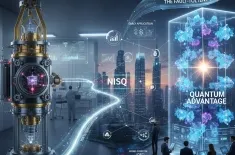Explore how 6G technology and the terahertz spectrum will revolutionize future compute networks.
The evolution of wireless communication has always been a catalyst for paradigm shifts in computing. From 3G enabling mobile internet access to 5G unlocking edge computing and the Internet of Things (IoT), each generation has fundamentally altered where, when, and how computation occurs. As we stand at the precipice of the next leap, 6G technology promises to be more than just a faster network; it is poised to create an entirely new symbiotic relationship between communication and computation, effectively dissolving the boundary between the two.
Anticipating the infrastructural requirements and new computing paradigms enabled by the far greater speed and bandwidth of future 6G networks, we recognize that the core impact will be the decentralization and hyper-distribution of processing power. This forthcoming generation is expected to offer speeds up to 1 terabit per second (Tbps)—a massive jump from 5G's typical peak of 10 Gigabits per second (Gbps)—and ultra-low latency measured in microseconds, creating a foundation for true distributed intelligence across the globe.
The Technological Pillars of 6G
The radical increase in performance promised by 6G rests on several foundational technological pillars:
The Terahertz Spectrum and Immense Bandwidth
The most significant enabler of 6G’s speed is the utilization of the terahertz spectrum (THz, 0.1 THz to 10 THz). This portion of the electromagnetic spectrum offers vast, contiguous bandwidths—orders of magnitude greater than the millimeter-wave (mmWave) frequencies used by 5G.
- Impact on Data Transfer: Access to the terahertz spectrum will facilitate data rates sufficient for real-time holographic communication, digital twinning of vast industrial complexes, and instantaneous synchronization of massive datasets.
- A Computational Link: The THz band doesnt just improve communication; it fundamentally changes the nature of data transfer. When data moves that fast, the network effectively becomes a near-instantaneous, virtual backplane for computing resources. This allows geographically separated servers or edge devices to act as a single, cohesive compute unit, erasing the physical distance bottleneck that currently plagues distributed intelligence.
Ultra-Low Latency and Real-Time Feedback
While 5G achieved latency of around 1 millisecond (ms), 6G aims for ultra-low latency of less than 100 microseconds (µs).
- Deterministic Communication: This sub-millisecond, deterministic response time is crucial for time-sensitive applications that require instantaneous, tactile feedback. Examples include remote surgery, high-frequency algorithmic trading, and vehicle-to-everything (V2X) communication required for fully autonomous driving fleets.
- Enabling Edge AI: This low latency is the key factor enabling true distributed intelligence. Compute tasks can be offloaded, processed, and returned in less time than it takes for human perception, allowing edge nodes to function as seamless, real-time extensions of central cloud resources.
Massive Connectivity and the Hyper-Connected World
6G technology is designed to support a vastly greater density of devices per square kilometer than 5G. This massive connectivity is not just about connecting more smartphones; its about connecting billions of sensors, actuators, and miniature computing modules embedded in the physical environment.
- IoT Evolution: This transforms the current Internet of Things (IoT) into the Internet of Everything (IoE) or the Internet of Senses, where every object is not only connected but is also a source of data and potentially a small compute node.
- Data Generation: The sheer scale of data generated by this massive connectivity necessitates an equally massive, decentralized computing infrastructure, pushing computation outward to the very endpoints of the network.
The Decentralization of Computing Power (Future Compute Networks)
The fundamental impact of 6G is the transition from a hierarchical, cloud-centric model to a truly pervasive and decentralized model of computation. This defines the nature of future compute networks.
Hyper-Edge Computing
6G technology will push computing power far beyond the current concept of the edge. The combination of ultra-low latency and massive connectivity will enable Hyper-Edge Computing where intelligence resides at the nearest possible point of data collection.
- Micro-Centers and Fog Computing: Dedicated micro-data centers may be embedded in city infrastructure (e.g., streetlights, traffic hubs), forming a dense fog layer that handles nearly all real-time processing locally.
- Computational Offloading: Devices will seamlessly and dynamically offload compute-intensive tasks to the nearest, most appropriate processing node—whether it’s a nearby phone, a base station, or a micro-center—all orchestrated by the 6G network itself. This makes the local devices limited processing power irrelevant for many applications.
Integrated Sensing, Communication, and Computing (ISCC)
A key architectural change in 6G technology is the integration of sensing, communication, and computing into a single unified system. The network infrastructure itself will become an intelligent sensor.
- The Network as a Sensor: Base stations, utilizing the terahertz spectrum, will be able to sense the environment (e.g., identifying objects, mapping surroundings, detecting human gestures). This massive sensing capability generates a continuous stream of environmental data that requires immediate, local processing by the distributed intelligence framework.
- Compute-Aware Communication: The 6G network will be inherently compute-aware, meaning it will optimize routing and resource allocation not just based on bandwidth needs, but also based on the computational load and capability of the connected devices.
The Distributed Intelligence Paradigm
Distributed intelligence is the ultimate goal, where AI models are broken down, trained, and executed across many different nodes, from the cloud down to the chip embedded in a sensor.
- Federated Learning on Steroids: FL, which currently faces bottlenecks due to latency and limited client availability, will become instantaneous and pervasive. Training and deploying highly complex, personalized AI models across a billion devices will happen in real-time, leveraging the ultra-low latency future compute networks enable.
- Collaborative AI: Complex tasks, like creating a massive digital twin of an entire city, will be collaboratively computed by thousands of localized, interconnected processing units, each handling its own section and communicating results instantly via the terahertz spectrum.
Infrastructural Requirements and Challenges for 6G Compute
Achieving the vision of 6G requires overcoming significant hardware and software hurdles that go beyond simply installing new antennas.
Hardware and Energy Demands
The specialized hardware required to operate in the terahertz spectrum and handle the immense throughput will be highly energy-intensive.
- Efficient Chips: New energy-efficient processing architectures, including neuromorphic chips and specialized AI accelerators at the edge, will be essential to manage the massive influx of data and maintain the sustainability of **massive connectivity**.
- Thermal Management: THz transceivers and high-performance **on-device training** compute units generate significant heat, demanding innovative cooling solutions, especially in small-footprint **future compute networks** devices.
Network Architecture and Software
The management of a future compute networks that is both communication *and* compute-aware necessitates a highly dynamic and flexible network architecture.
- Digital Twins for Optimization: The network itself will likely rely on a Digital Twin—a virtual replica—to model, predict, and dynamically adjust resource allocation, ensuring the **ultra-low latency** guarantee is met for all services.
- Compute Orchestration: New software layers, often driven by AI itself, must be developed to intelligently manage distributed intelligence tasks, deciding whether a specific computation should be run locally, offloaded to a nearby **6G technology** micro-center, or sent to the distant cloud.
Conclusion: The Computational Singularity
6G technology represents a quantum leap that dissolves the conceptual divide between network infrastructure and computing infrastructure. Leveraging the immense bandwidth of the terahertz spectrum, supporting massive connectivity, and guaranteeing ultra-low latency, 6G creates the bedrock for true distributed intelligence. The resulting future compute networks will feature intelligence pervasive throughout the environment, from the deepest cloud to the smallest sensor chip.
This is not just faster internet; it is the infrastructure for a computational singularity where every device is a powerful, interconnected processing node, fundamentally redefining human-machine interaction and enabling real-time, collaborative AI at a global scale. The impact on computing power will be profound, making current concepts of centralized processing obsolete and ushering in an era of seamlessly integrated, intelligent digital-physical worlds.
Digital Twinning and Metaverse Realization
The most demanding computational task for 6G will be supporting the creation and maintenance of vast, real-time digital twins of the physical world.
- Real-time Synchronization: A digital twin of a factory or a city requires constant, simultaneous input from millions of sensors (enabled by **massive connectivity**), which must be processed and reflected in the virtual model with **ultra-low latency**. The computational load for rendering, modeling physics, and running predictive AI simulations for a city-scale twin is enormous.
- Distributed Processing: This entire simulation cannot run on a single cloud server. Instead, sections of the digital twin will be managed by local **future compute networks** nodes—a traffic intersection managed by a micro-edge server, a building managed by its internal server. The 6G network acts as the high-speed backbone, utilizing the **terahertz spectrum** to aggregate and synchronize these geographically **distributed intelligence** components instantly.
Personal Health and Neuro-Computing
6G’s compute power will revolutionize personalized medicine by enabling real-time integration of bio-data.
- Wearable AI: Advanced, complex AI models for diagnosing conditions or predicting health events will run on highly sophisticated wearables. The limited power of the wearable requires constant, **ultra-low latency** offloading of computation to nearby network nodes.
- Brain-Computer Interfaces (BCI): BCIs, which require instantaneous processing of neural signals to control external devices, demand latency in the microsecond range. The necessary **distributed intelligence** will involve the BCI device, a nearby edge processing unit, and a remote cloud, all acting in seamless concert via the 6G network. The sheer volume of data generated by high-resolution BCI requires the throughput only the **terahertz spectrum** can provide.
Computational Sensing and Security
The integration of sensing and communication turns the network into a vast computational sensor grid.
- Pervasive Environmental Mapping: The network itself can become a high-resolution radar system, passively mapping everything from air quality to infrastructure integrity. This generates petabytes of data requiring instant fusion and processing by the nearest **distributed intelligence** server.
- AI-Native Security: Security mechanisms will shift from reactive firewalls to proactive, **distributed intelligence** systems. AI models running on every network node, enabled by on-device training and the **massive connectivity** framework, will instantly detect anomalies, isolate threats, and collaborate across the **future compute networks** in real-time—a task impossible under current latency and bandwidth constraints.
Quantum Integration and Hybrid Computing
Looking ahead, the vast computational power of 6G will be required to manage the integration of quantum computing resources.
- Quantum Cloud Access: Access to remote quantum processors will require near-perfect synchronization and vast data transfer capabilities to send complex quantum circuit configurations and receive results. The **terahertz spectrum** is essential for maintaining the integrity and speed of this data exchange.
- Orchestrating Hybrid Tasks: Many computationally intense problems will be split into classical processing parts and quantum processing parts. The 6G network and its orchestration layer will manage this hybrid computing model, dynamically allocating the classical parts to optimized edge servers and routing the quantum parts to specialized processors with **ultra-low latency**.
The cumulative effect of these applications solidifies the need for **6G technology** as the foundational layer for **future compute networks**. The transition is not simply about faster data; it is about creating a computationally aware network that autonomously manages **distributed intelligence** and **massive connectivity** to power an unprecedented level of real-time digital interaction. The entire digital infrastructure becomes a single, fluid, and hyper-responsive processing unit.

































